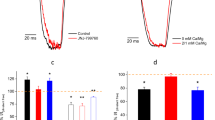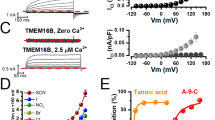Abstract
The effects of external divalent cations on the steady-state open probability (P o), opening and closing rates, and conductance of batrachotoxin (BTX)-activated Na channels were studied in planar lipid bilayers. External divalent cations shifted the midpoint of the P o versus membrane potential (V m) relation (gating curve) to more depolarized potentials. Of the group IIA divalent cations tested, Ca2+ caused the largest depolarizing shift followed by Ba2+, Sr2+ and Mg2+ in that order. In contrast, the order of decreasing efficacy for block of the single channel conductance was Ca2+, Mg2+, Sr2+ and Ba2+. Thus, because it is a relatively good shifter but a poor blocker, Ba2+ was used to study the effects of divalent cations on gating. External Ba2+ decreased the Na channel opening rate and increased the closing rate. At voltages close to the midpoint of the gating curve, the opening rate decreased by a factor of 1/2.8 while the closing rate increased by 2.0-fold. Although Ba2+ would be expected to increase the external surface potential by interacting with negatively charged residues on the channel, this preferential effect on the opening rate indicates that the effects of external Ba2+ cannot be attributed solely to an increase in the potential gradient across the voltage sensing apparatus. Our results can be explained if two different mechanisms are involved in the modulation of Na channel gating by extracellular divalent cations in neutral membranes: (1) the screening or binding of Ba2+ at negatively charged groups on the extracellular side of the channel, leading to an increase in the transmembrane electric field at the voltage sensor, as well as an increase in the closing rate and decrease in the opening rate by the same proportion, plus (2) a direct modulatory action on the channel protein which stabilizes the closed state of the channel and accounts for the larger effect of external divalent cations on the opening rate.
Similar content being viewed by others
References
Behrens MI, Oberhauser A, Bezanilla F, Latorre R (1989) Batrachotoxin-modified sodium channels from squid optic nerve in planar bilayers. Ion conduction and gating properties. J Gen Physiol 93:23–41
Brink F (1954) The role of calcium in neural processes. Pharmacol Rev 6:243–278
Catterall WA (1986) Voltage-dependent gating of sodium channels: correlating structure and function. Trends Neurosci 9:7–10
Cukierman S, Zinkand WC, French RJ, Krueger BK (1988) Effects of membrane surface charge and calcium on the gating of rat brain sodium channels in planar bilayers. J Gen Physiol 92:431–447
Frankenhaeuser B, Hodgkin AL (1957) The action of calcium on the electrical properties of squid axons. J Physiol (Lond) 137:218–244
French RJ, Worley JF, Blaustein MB, Romine WO, Tam KK, Krueger BK (1986) Gating of batrachotoxin-activated sodium channels in lipid bilayers. In: Miller C (ed) Ion channel reconstitution. Plenum, New York, p 363
Gilly WF, Armstrong CM (1982a) Slowing of sodium channel opening kinetics in squid axon by extracellular zinc. J Gen Physiol 79:935–964
Gilly WF, Armstrong CM (1982b) Divalent cations and the activation kinetics of potassium channels in squid giant axons. J Gen Physiol 79:965–996
Green WN, Weiss LB, Andersen OS (1987) Batrachotoxin-modified sodium channels in planar lipid bilayers. J Gen Physiol 89:841–872
Guy HR (1987) A model relating the structure of the sodium channel to its function. In: Agnew W (ed) Current topics in membranes and transport, vol 33. Academic Press, San Diego, p 289
Hahin R, Campbell DT (1983) Simple shifts in the voltage dependence of sodium channel gating caused by divalent cations. J Gen Physiol 82:785–805
Hille B, Woodhull AM, Shapiro BI (1975) Negative surface charge near sodium channels of nerve: divalent ions, monovalent ions, and pH. Philos Trans Soc Lond [Biol] B 270:301–318
Huang L-YM, Moran N, Ehrenstein G (1984) Gating kinetics of batrachotoxin-modified sodium channels in neuroblastoma cells determined from single-channel measurements. Biophys J 45:313–321
Israelachvili JN (1985) Intermolecular and surface forces. Academic Press, London
Keller BU, Hartshorne RP, Talvenheimo JA, Catterall WA, Montal M (1986) Sodium channels in planar lipid bilayers. Channel gating kinetics of purified sodium channels modified by batrachotoxin. J Gen Physiol 88:1–23
Krueger BK, Ratzlaff RW, Strichartz GR, Blaustein MP (1979) Saxitoxin binding to synaptosomes, membranes, and solubilized binding sites from rat brain. J Membr Biol 50:287–310
Krueger BK, Worley JF, French RJ (1983) Single sodium channels from rat brain incorporated into planar lipid bilayers. Nature 303:172–175
McLaughlin S (1977) Electrostatic potentials at membrane-solution interfaces. Curr Top Membr Transp 9:71–144
Moczydlowski E, Garber SS, Miller C (1984) Batrachotoxin-activated Na+ channels in planar lipid bilayers. Competition of tetrodotoxin block by Na+. J Gen Physiol 84:665–686
Noda M, Takayuki I, Kayano T, Suzuki H, Takeshima H, Kurasaki M, Takahashi M, Numa S (1986) Existence of distinct sodium channel messenger RNAs in rat brain. Nature 320:188–192
Pallotta BS, Magleby KL, Barrett JN (1981) Single channel recordings of Ca2+-activated K+ currents in rat muscle cell culture. Nature 293:471–474
Schreiner W, Michael W, Krischer S, Langsam Y (1985) Nonlinear least-squares fitting. PC Tech J 170–181
Tsien RW, Hess P, McCleskey EW, Rosenberg RL (1987) Calcium channels: mechanisms of selectivity, permeation, and block. Annu Rev Biophys Biophys Chem 16:265–290
Woodhull AM (1973) Ionic blockage of sodium channels in nerve. J Gen Physiol 61:687–708
Worley JF, French RJ, Krueger BK (1986) Trimethyloxonium modification of single batrachotoxin-activated sodium channels in planar bilayers. Changes in unit conductance and in block by saxitoxin and calcium. J Gen Physiol 87:327–349
Yamamoto D, Yeh JZ, Narahashi T (1984) Voltage dependent calcium block of normal and tetramethrin-modified single sodium channels. Biophys J 45:337–344
Author information
Authors and Affiliations
Rights and permissions
About this article
Cite this article
Cukierman, S., Krueger, B.K. Modulation of sodium channel gating by external divalent cations: differential effects on opening and closing rates. Pflügers Arch 416, 360–367 (1990). https://doi.org/10.1007/BF00370741
Received:
Revised:
Accepted:
Issue Date:
DOI: https://doi.org/10.1007/BF00370741




